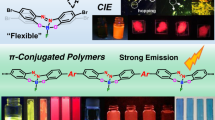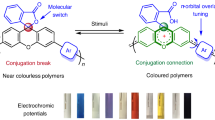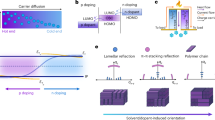Abstract
Diverse functionalized insulated conjugated polymers (ICPs) were synthesized via co-polymerization between insulated conjugated monomers and various functional units. Such polymers possessed well-defined, linked-rotaxane structures with target-specific insulations through a fine-synthetic technique. The functional moieties on the polymer backbones strongly affected their π-conjugation, which afforded sensitivity toward external stimuli. Chemical and physical inputs, such as redox, light, ions and gases, could be detected by modulating their optical and electrical properties. Moreover, the linked-rotaxane insulating structures inhibited undesired π–π interactions between chains and prohibited thermal fluctuation in the conjugated backbones. The rotaxane structures efficiently enhanced the processabilities and physical properties of the sensing materials. Accordingly, cooperative effects were observed between the insulation and functional moieties in functionalized ICPs. In this review, sophisticated material designs and synthetic strategies toward functionalized ICPs will be described with a focus on reversible sensing of external stimuli.
Similar content being viewed by others
Log in or create a free account to read this content
Gain free access to this article, as well as selected content from this journal and more on nature.com
or
References
Roncali, J. Molecular engineering of the band gap of π-conjugated systems: facing technological applications. Macromol. Rapid Commun. 28, 1761–1775 (2007).
Ostroverkhova, O. Organic optoelectronic materials: mechanisms and applications. Chem. Rev. 116, 13279–13412 (2016).
AlSalhi, M. S., Alam, J., Dass, L. A. & Raja, M. Recent advances in conjugated polymers for light emitting devices. Int. J. Mol. Sci. 12, 2036–2054 (2011).
Guo, X., Baumgarten, M. & Müllen, K. Designing π-conjugated polymers for organic electronics. Prog. Polym. Sci. 38, 1832–1908 (2013).
Kularatne, R. S., Magurudeniya, H. D., Sista, P., Biewer, M. C. & Stefan, M. C. Donor-acceptor semiconducting polymers for organic solar cells. J. Polym. Sci. A Polym. Chem. 51, 743–768 (2013).
Yan, Y., Liu, X. & Wang, T. Conjugated-polymer blends for organic photovoltaics: rational control of vertical stratification for high performance. Adv. Mater. 29 (2017).
Wu, C. & Chiu, D. T. Highly fluorescent semiconducting polymer dots for biology and medicine. Angew. Chem. Int. Ed. 52, 3086–3109 (2013).
Cornil, J., Heeger, A. J. & Bredas, J. L. Effects of intermolecular interactions on the lowest excited state in luminescent conjugated polymers and oligomers. Chem. Phys. Lett. 272, 463–470 (1997).
Frampton, M. & Anderson, H. Insulated molecular wires. Angew. Chem. Int. Ed. 46, 1028–1064 (2007).
Pan, C., Zhao, C., Takeuchi, M. & Sugiyasu, K. Conjugated oligomers and polymers sheathed with designer side chains. Chem Asian J. 10, 1820–1835 (2015).
Ikeda, T., Higuchi, M. & Kurth, D. G. From thiophene [2]rotaxane to polythiophene polyrotaxane. J. Am. Chem. Soc. 131, 9158–9159 (2009).
Jia, Y., Malveau, C., Mezour, M. A., Perepichka, D. F. & Zhu, X. X. A molecular necklace: threading β-cyclodextrins onto polymers derived from bile acids. Angew. Chem. Int. Ed. 55, 11979 (2016).
Cacialli, F., Wilson, J. S., Michels, J. J., Daniel, C., Silva, C., Friend, R. H., Severin, N., Samori, P., Rabe, J. P., O’Connell, M. J., Taylor, P. N. & Anderson, H. L. Cyclodextrin-threaded conjugated polyrotaxanes as insulated molecular wires with reduced interstrand interactions. Nat. Mater. 1, 160–164 (2002).
Sugiyasu, K., Honsho, Y., Harrison, R. M., Sato, A., Yasuda, T., Seki, S. & Takeuchi, M. A self-threading polythiophene: defect-free insulated molecular wires endowed with long effective conjugation length. J. Am. Chem. Soc. 132, 14754–14756 (2010).
Taniguchi, M., Nojima, Y., Yokota, K., Terao, J., Sato, K., Kambe, N. & Kawai, T. Self-organized interconnect method for molecular devices. J. Am. Chem. Soc. 128, 15062–15063 (2006).
Pan, C., Sugiyasu, K., Wakayama, Y., Sato, A. & Takeuchi, M. Thermoplastic fluorescent conjugated polymers: benefits of preventing π-π stacking. Angew. Chem. Int. Ed. 52, 10775–10779 (2013).
Yoshida, K., Shimomura, T., Ito, K. & Hayakawa, R. Inclusion complex formation of cyclodextrin and polyaniline. Langmuir 15, 910–913 (1999).
Wenz, G., Han, B.-H. & Müller, A. Cyclodextrin rotaxanes and polyrotaxanes. Chem. Rev. 106, 782–817 (2006).
van den Boogaard, M., Bonnet, G., van’t Hof, P., Wang, Y., Brochon, C., van Hutten, P., Lapp, A. & Hadziioannou, G. Synthesis of insulated single-chain semiconducting polymers based on polythiophene, polyfluorene, and α-cyclodextrin. Chem. Mater. 16, 4383–4385 (2004).
Shinohara, K., Suzuki, T., Kitami, T. & Yamaguchi, S. Simultaneous imaging of the structure and fluorescence of a supramolecular nanostructure formed by the coupling of π-conjugated polymer chains in the intermolecular interaction. J. Polym. Sci. A Polym. Chem. 44, 801–809 (2006).
Sakamoto, K., Takashima, Y., Yamaguchi, H. & Harada, A. Preparation and properties of rotaxanes formed by dimethyl- β -cyclodextrin and oligo(thiophene)s with β -cyclodextrin stoppers. J. Org. Chem. 72, 459–465 (2007).
Liu, Y., Zhao, Y.-L., Zhang, H.-Y. & Song, H.-B. Polymeric rotaxane constructed from the inclusion complex of β-cyclodextrin and 4,4’-dipyridine by coordination with nickel(II) ions. Angew. Chem. Int. Ed. 42, 3260–3263 (2003).
Yang, Y.-W., Chen, Y. & Liu, Y. Linear polypseudorotaxanes possessing many metal centers constructed from inclusion complexes of α -, β -, and γ -cyclodextrins with 4,4’-dipyridine. Inorg. Chem. 45, 3014–3022 (2006).
Yoshihara, D., Tsuchiya, Y., Noguchi, T., Yamamoto, T., Dawn, A. & Shinkai, S. Cyclodextrin-assisted synthesis of a metallosupramolecular terbium(III) polymer and its fluorescence properties and chiral recognition. Chem Eur. J. 19, 15485–15488 (2013).
Terao, J., Tanaka, Y., Tsuda, S., Kambe, N., Taniguchi, M., Kawai, T., Saeki, A. & Seki, S. Insulated molecular wire with highly conductive π-conjugated polymer core. J. Am. Chem. Soc. 131, 18046–18047 (2009).
Terao, J., Tsuda, S., Tanaka, Y., Okoshi, K., Fujihara, T., Tsuji, Y. & Kambe, N. Synthesis of organic-soluble conjugated polyrotaxanes by polymerization of linked rotaxanes. J. Am. Chem. Soc. 131, 16004–16005 (2009).
Terao, J., Ikai, K., Kambe, N., Seki, S., Saeki, A., Ohkoshi, K., Fujihara, T. & Tsuji, Y. Synthesis of a head-to-tail-type cyclodextrin-based insulated molecular wire. Chem. Commun. 47, 6816 (2011).
Pan, C., Sugiyasu, K. & Takeuchi, M. Blending conjugated polymers without phase separation for fluorescent colour tuning of polymeric materials through FRET. Chem. Commun. 50, 11814–11817 (2014).
Masai, H., Fujihara, T., Tsuji, Y. & Terao, J. Programed synthesis of molecular wires with fixed insulation and defined length based on oligo(phenylene ethynylene) and permethylated α-cyclodextrins. Chem. Eur. J. e-pub ahead of print 3 June 2017; doi: 10.1002/chem.201701428
Kiguchi, M., Nakashima, S., Tada, T., Watanabe, S., Tsuda, S., Tsuji, Y. & Terao, J. Single-molecule conductance of π-conjugated rotaxane: new method for measuring stipulated electric conductance of π-conjugated molecular wire using STM break junction. Small 8, 726–730 (2012).
Terao, J., Wadahama, A., Matono, A., Tada, T., Watanabe, S., Seki, S., Fujihara, T. & Tsuji, Y. Design principle for increasing charge mobility of π-conjugated polymers using regularly localized molecular orbitals. Nat. Commun. 4, 1691 (2013).
Green, J. E., Wook Choi, J., Boukai, A., Bunimovich, Y., Johnston-Halperin, E., DeIonno, E., Luo, Y., Sheriff, B. A., Xu, K., Shik Shin, Y., Tseng, H.-R., Stoddart, J. F. & Heath, J. R. A 160-kilobit molecular electronic memory patterned at 1011 bits per square centimetre. Nature 445, 414–417 (2007).
Milan, D. C., Krempe, M., Ismael, A. K., Movsisyan, L. D., Franz, M., Grace, I., Brooke, R. J., Schwarzacher, W., Higgins, S. J., Anderson, H. L., Lambert, C. J., Tykwinski, R. R. & Nichols, R. J. The single-molecule electrical conductance of a rotaxane-hexayne supramolecular assembly. Nanoscale 9, 355–361 (2017).
Fujimoto, T., Sakata, Y. & Kaneda, T. The first Janus [2]rotaxane. Chem. Commun. 2143–2144 (2000).
Masai, H., Terao, J., Fujihara, T. & Tsuji, Y. Rational design for rotaxane synthesis through intramolecular slippage: control of activation energy by rigid axle length. Chem. Eur. J. 22, 6624–6630 (2016).
Terao, J., Masai, H., Fujihara, T. & Tsuji, Y. Synthesis of insulated pt—alkynyl complex polymer. Chem. Lett. 41, 652–653 (2012).
Masai, H., Terao, J., Seki, S., Nakashima, S., Kiguchi, M., Okoshi, K., Fujihara, T. & Tsuji, Y. Synthesis of one-dimensional metal-containing insulated molecular wire with versatile properties directed toward molecular electronics materials. J. Am. Chem. Soc. 136, 1742–1745 (2014).
Terao, J., Homma, K., Konoshima, Y., Imoto, R., Masai, H., Matsuda, W., Seki, S., Fujihara, T. & Tsuji, Y. Synthesis of functionalized insulated molecular wires by polymerization of an insulated π-conjugated monomer. Chem. Commun. 50, 658–660 (2014).
Hosomi, T., Masai, H., Fujihara, T., Tsuji, Y. & Terao, J. A typical metal-ion-responsive color-tunable emitting insulated π-conjugated polymer film. Angew. Chem. Int. Ed. 55, 13427–13431 (2016).
Hosomi, T., Masai, H., Matsuda, W., Seki, S., Fujihara, T., Tsuji, Y. & Terao, J. Synthesis of highly insulated conjugated metallopolymers containing terpyridine-metal complexes. Chem. Lett. 45, 931–933 (2016).
Tsuda, S., Terao, J., Tanaka, Y., Maekawa, T. & Kambe, N. Synthesis of linked symmetrical [3] and [5]rotaxanes having an oligomeric phenylene ethynylene (OPE) core skeleton as a π-conjugated guest via double intramolecular self-inclusion. Tetrahedron Lett. 50, 1146–1150 (2009).
Mori, M. Regio- and stereoselective synthesis of tri- and tetrasubstituted alkenes by introduction of CO2 and alkylzinc reagents into alkynes. Eur. J. Org. Chem. 2007, 4981–4993 (2007).
Saeki, A., Koizumi, Y., Aida, T. & Seki, S. Comprehensive approach to intrinsic charge carrier mobility in conjugated organic molecules, macromolecules, and supramolecular architectures. Acc. Chem. Res. 45, 1193–1202 (2012).
Jana, A., Ishida, M., Park, J. S., Bähring, S., Jeppesen, J. O. & Sessler, J. L. Tetrathiafulvalene- (TTF-) derived oligopyrrolic macrocycles. Chem. Rev. 117, 2641–2710 (2017).
Irie, M., Fukaminato, T., Matsuda, K. & Kobatake, S. Photochromism of diarylethene molecules and crystals: memories, switches, and actuators. Chem. Rev. 114, 12174–12277 (2014).
Terao, J., Homma, K., Konoshima, Y., Taniguchi, M., Kiguchi, M., Komoto, Y., Horikawa, M., Naito, Y., Fujihara, T. & Tsuji, Y. Molecular wiring method based on polymerization or copolymerization of an insulated π-conjugated monomer. Bull. Chem. Soc. Jpn 87, 871–873 (2014).
Terao, J., Kimura, K., Seki, S., Fujihara, T. & Tsuji, Y. Synthesis of an insulated molecular wire by click polymerization. Chem. Commun. 48, 1577–1579 (2012).
Yang, B., Tian, L., Zhang, H., Zhang, W., Xu, H., Xie, Z., Lu, P., Zhang, M., Yu, J., Lu, D., Ma, Y., Shen, J. & Liu, X. Nature of zinc(II)-induced ionochromic effect of bipyridine-containing conjugated polymers: an electrostatic interaction mechanism. J. Phys. Chem. B 110, 16846–16851 (2006).
Dul, M.-C., Pardo, E., Lescouëzec, R., Journaux, Y., Ferrando-Soria, J., Ruiz-García, R., Cano, J., Julve, M., Lloret, F., Cangussu, D., Pereira, C. L. M., Stumpf, H. O., Pasán, J. & Ruiz-Pérez, C. Supramolecular coordination chemistry of aromatic polyoxalamide ligands: A metallosupramolecular approach toward functional magnetic materials. Coord. Chem. Rev. 254, 2281–2296 (2010).
Zhao, Q., Li, F. & Huang, C. Phosphorescent chemosensors based on heavy-metal complexes. Chem. Soc. Rev. 39, 3007 (2010).
Burnworth, M., Tang, L., Kumpfer, J. R., Duncan, A. J., Beyer, F. L., Fiore, G. L., Rowan, S. J. & Weder, C. Optically healable supramolecular polymers. Nature 472, 334–337 (2011).
Masai, H., Terao, J. & Tsuji, Y. Insulated π-conjugated metallopolymers. Tetrahedron Lett. 55, 4035–4043 (2014).
Wong, W. Y. & Harvey, P. D. Recent progress on the photonic properties of conjugated organometallic polymers built upon the trans-Bis(paraethynylbenzene)bis(phosphine)platinum(II) chromophore and related derivatives. Macromol. Rapid Commun. 31, 671–713 (2010).
Ho, C.-L. & Wong, W.-Y. Metal-containing polymers: Facile tuning of photophysical traits and emerging applications in organic electronics and photonics. Coord. Chem. Rev. 255, 2469–2502 (2011).
Terao, J., Hosomi, T., Masai, H., Matsuda, W., Seki, S. & Fujihara, T. Synthesis and redox response of insulated molecular wire elongated through iron-terpyridine coordination bonds. Chem. Lett. 43, 1289–1291 (2014).
Marvaud, V. & Launay, J. P. Control of intramolecular electron transfer by protonation: oligomers of ruthenium porphyrins bridged by 4,4’-azopyridine. Inorg. Chem. 32, 1376–1382 (1993).
Barley, M. H., Dolphin, D. & James, B. R. Reversible intramolecular electron transfer within a ruthenium(III) porphyrin-ruthenium(II) porphyrin π-cation radical system induced by changes in axial ligation. J. Chem. Soc., Chem. Commun. 1499–1500 (1984).
Ohto, T., Masai, H., Terao, J., Matsuda, W., Seki, S., Tsuji, Y. & Tada, H. Enhancement of carrier mobility through deformation potential in metal-containing insulated molecular wires. J. Phys. Chem. C 120, 26637–26644 (2016).
Beljonne, D., Wittmann, H. F., Köhler, A., Graham, S., Younus, M., Lewis, J., Raithby, P. R., Khan, M. S., Friend, R. H. & Brédas, J. L. Spatial extent of the singlet and triplet excitons in transition metal-containing poly-ynes. J. Chem. Phys. 105, 3868–3877 (1996).
Masai, H., Terao, J., Makuta, S., Tachibana, Y., Fujihara, T. & Tsuji, Y. Enhancement of phosphorescence and unimolecular behavior in the solid state by perfect insulation of platinum-acetylide polymers. J. Am. Chem. Soc. 136, 14714–14717 (2014).
Terao, J., Konoshima, Y., Matono, A., Masai, H., Fujihara, T. & Tsuji, Y. Synthesis of an organic-soluble π-conjugated [3]rotaxane via rotation of glucopyranose units in permethylated β-cyclodextrin. Beilstein J. Org. Chem. 10, 2800–2808 (2014).
Acknowledgements
This research was supported by the Funding Program for JSPS Research Fellows and Grant-in-Aid for Scientific Research (B) and Scientific Research on Innovative Areas (‘Molecular Architectonics’ and ‘Soft Molecular Systems’) from MEXT, Japan. This research was also supported by Tokuyama Science Foundation and CREST, JST.
Author information
Authors and Affiliations
Corresponding author
Ethics declarations
Competing interests
The authors declare no conflict of interest.
Rights and permissions
About this article
Cite this article
Masai, H., Terao, J. Stimuli-responsive functionalized insulated conjugated polymers. Polym J 49, 805–814 (2017). https://doi.org/10.1038/pj.2017.57
Received:
Revised:
Accepted:
Published:
Issue date:
DOI: https://doi.org/10.1038/pj.2017.57



